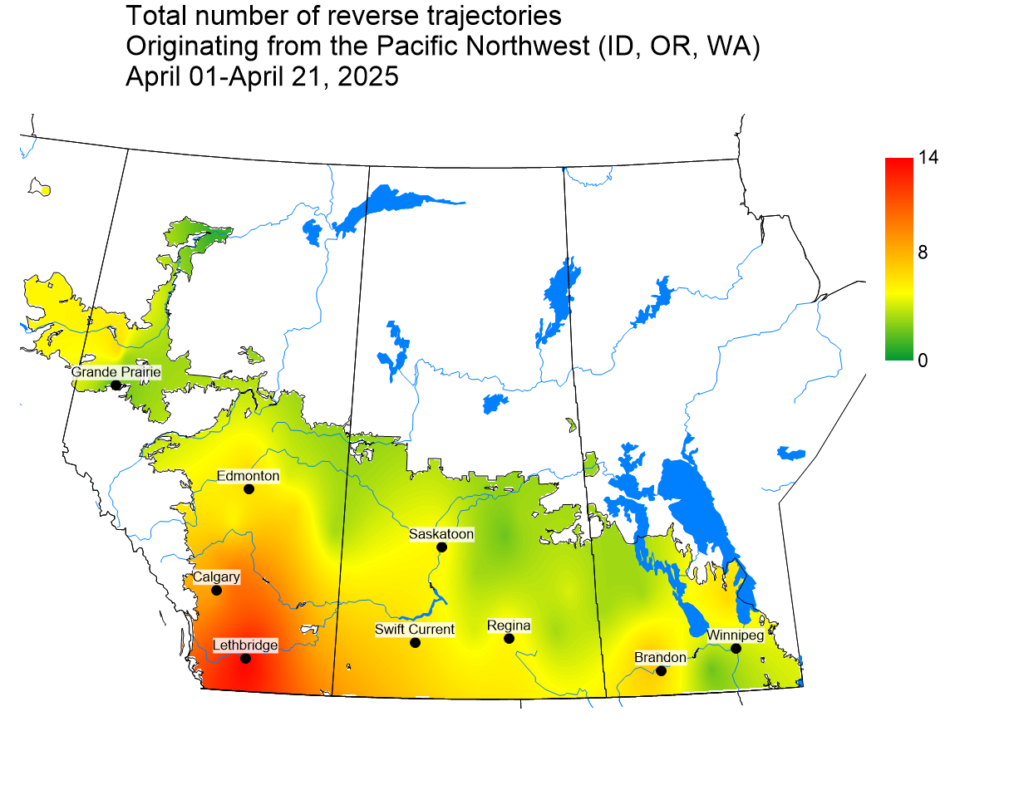Since the PCDMN rust risk update in early February 2025 (https://prairiecropdisease.com/2025/02/02/2025-pnw-stripe-rust-forecast-a-heads-up-for-prairie-wheat-growers/) there has been a change in rust risk coming out of the Pacific Northwest. Dr. Xianming Chen, USDA-ARS, and WSU, Pullman, WA, issues one or more stripe rust forecasts for the PNW region in the USA. Unfortunately, winter wheat crops in the PNW region serve as an important source of stripe rust inoculum for Prairie producers. These PNW forecasts from Dr. Chen serve as a heads-up for Prairie cereal producers regarding potential issues with stripe rust in the coming growing season.
Dr. Chen evaluates weather data (mainly temperatures) from November to February of each year as it impacts potential overwintering and subsequent development of stripe rust on PNW winter wheat crops. In his March 5, 2025 risk update, Dr. Chen indicated that the 2025 forecast was downgraded from severe in January 2025 to low in early March 2025 Stripe Rust Forecast, March 5, 2025 | Stripe Rust | Washington State University). This change from early January to early February was based primarily on cold February temperatures that are less conducive to overwintering of the stripe rust pathogen. In early March the forecasted low risk with 18% yield losses for susceptible wheat varieties, down from 41% based on his early January forecast. In early March 2025, Dr. Chen and colleagues did not observe stripe rust in winter wheat fields (commercial and research), compared to several observations of this disease in late February 2024. As of March 5, 2025, Dr. Chen’s recommendation for the eastern regions of the Pacific Northwest was that fungicides were not recommended, except where symptoms are observed later in spring/summer 2025.
As of April 18, 2025, Dr. Chen updated the stripe rust situation in the Pacific Northwest to indicate stripe rust symptoms were observed in several research fields, but not around the Pullman area (Stripe Rust Update, April 18, 2025 | Stripe Rust | Washington State University). Observations made in early April indicated where stripe rust was present in research fields it was at lower levels versus the same time in 2024. Of note were higher levels in western Washington at the Mount Vernon trial location, which typically has increased levels of stripe rust each year. In addition, compared to 2024 higher stripe rust levels were found at their winter wheat trial site in Garfield County at Central Ferry, WA. Overall, Dr. Chen indicates the occurrence of symptoms in 2025 has been later versus 2024. Given these recent observations, Dr. Chen is now recommending fungicide application on susceptible to moderately susceptible varieties at the time of spring herbicide applications, especially where stripe rust severity or incidence is 5% or more. Dr. Chen also reported that in addition to stripe rust observations in Washington State and Oregon, rust symptoms have also been reported in Georgia (Dr. A. Martinez, UGA, stripe rust of wheat and crown rust of oat), Louisiana (Dr. S.A. Harrison, LSU, crown rust of oat, leaf and stripe rust of wheat), and Texas (Dr. B. Gerrish, TAMU, leaf and stripe rust), although generally at low levels.
Dr. K. Anderson Onofre, KSU, most recently indicated that the risk of stripe rust in Kansas as of April 23, 2025,was low with no current reports of stripe rust in Kansas (https://eupdate.agronomy.ksu.edu/article/should-you-spray-stripe-rust-and-other-wheat-diseases-to-watch-for-in-kansas-638-4). For 2025, Dr. Anderson Onofre, KSU, indicated a general rule of thumb is that if stripe rust is observed prior to mid April, then stripe rust risk in Kansas is higher, and thus with no current observations the risk is lower for 2025. Dr. Anderson Onofre also indicated that given observations of stripe and leaf rust in Texas, scouting fields for rust symptoms will be important for Kansas farmers.
The Prairie Crop Disease Network (PCDMN) is currently preparing for the 2025 growing season and will launch weekly cereal rust risk forecasts starting in mid May 2025. With the help of Environment Canada, we look at reverse wind trajectory occurrence and frequency for Prairie sites from the PNW, and Texas/Oklahoma, Kansas/Nebraska regions. These trajectories can readily move cereal stripe, leaf, stem and crown rust uredospores from source locations in the USA into the Prairie region. Typically trajectories from the PNW are of most concern for central to western Prairie cereal growers, while trajectories from the Texas to Nebraska corridor are of most concern for central to eastern Prairie growers. Courtesy of AAFC Lacombe Technician, Sasha Chisholm, preliminary reverse trajectory maps for the PNW and Kansas/Nebraska regions from April 1-21, 2025, indicate this.


The PCDMN cereal rust forecasts appear on the in-season updates section of our website, where one can can also review past in-season updates for a range of crops and disease issues. The in-season updates provide a summary of the weekly rust forecasts, while the Cereal Rust Risk section provides the full weekly reports from current and past growing seasons.
As the 2025 growing season approaches, the PCDMN will be monitoring further rust risk forecasts from Dr. Chen as well as the status of rust development in source USA locations. Further updates will be provided with weekly cereal rust risk forecasts starting around mid-May. Stay tuned and monitor our PCDMN website and X (Twitter) feed for further information.

